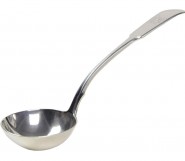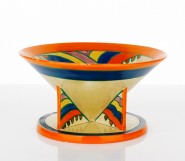Lot #591 - Joseph Backler
-
Auction House:Mossgreen
-
Sale Name:Australian & Colonial History
-
Sale Date:28 Jun 2016
-
Lot #:591
-
Lot Description:Joseph Backler
(circa 1813–1895)
(i) Portrait of Robert McPhillamy (circa 1850); oil on canvas; 92 x 76cm
(ii) Portrait of Catherine McPhillamy (circa 1850); oil on canvas; 92 x 76 cm -
Provenance:Australian and International Paintings, Christies, Melbourne, 24 November 1999, lot 78 (illustrated); Private collection, Melbourne
-
Notes:It is peculiar, and perhaps even an uncomfortable truth, that Australia’s first, and best, artists were largely convicts, or to be more precise, convicted forgers – at the time, a crime often punishable at the gallows. That these creative swindlers laid the foundations for the first artistic expressions in the Colony is of course to be expected in a prisoner dominated settler society. The list of forgers and counterfeiters sentenced to transportation is a weighty and illustrious one. It includes such eminent figures as the first convict artist Thomas Watling, the repeat offender Joseph Lycett, the solicitor George Edward Peacock, the portrait painter Richard Read Senior, the erudite Thomas Wainwright, and the Norwegian born Knut Bull – to name the more active of the lot. Another artist turned forger, then born again artist, was the Londoner Joseph Backler. Back in England, he was under the artistic tutelage of his father, Joseph Backler the elder, a glass painter of minor talent.1 Despite an otherwise privileged upbringing, Backler the younger responded to an impulse to produce a number of counterfeit money orders. He was sentenced to death, which was later reduced to transportation, and arrived in Sydney in 1832 at the age of 18. Here, for some time, he continued to get on the wrong side of the law before finally investing his artistic talents toward more noble ends; and within a decade and a half he distinguished himself as a portrait painter of moderate popularity among the prospering classes of New South Wales and Queensland.2 Between 1846 and until his death in 1895, Backler earned a living as an itinerant portrait painter, travelling great distances to create likenesses of the growing middle-class. Among his more notable works is the technically fine, though stiff and awkwardly modelled, posthumous historical portrait Captain Cook on the Coast of New South Wales 1860 (Art Gallery of South Australia, Adelaide). The present pair shows Robert McPhillamy (1818-1888) and his wife Catherine McPhillamy (1818-1896). Little is known about Catherine’s life; in 1841, she married Robert McPhillamy, a successful grazier and stud farmer in Gorman’s Hill, near Bathurst. Born in Windsor, New South Wales, MacPhillamy was the son of Scottish convicts, William and Mary. A devout Christian and a man of ambition, he set out to distance himself from his convict heritage and became an active member of the community, being sworn in as a Magistrate in Bathurst 1857.3 He appears to have kept a tight rein on his property, seeking, and obtaining, compensation from employees who absconded from work, and in one instance, from a shepherd who had ‘wilfully or negligently’, lost sixteen sheep.4 The couple experienced a series of tragic accidents: in 1858, Mrs McPhillamy was severely injured following a gig accident in Bathurst;5 their fourteen year old son James was killed in a horse riding accident in 1866; and eleven years later their twenty-two year old daughter, Kate Jane, died at Gorman’s Hill of unspecified causes.6 Although it is unclear precisely when Backler executed the present works, he is recorded residing in Bathurst in 1847, and possibly returned to complete more commissions for the township’s residents in 1850 and again in 1854.7 With their common convict background, one can easily imagine a degree of mutual affinity between Backler and Mr McPhillamy. A shared desire which looked to leave behind their stained past, determined to focus on their present fortunes and higher status in contemporary society. Regardless of exactly when they were painted, Portrait of Robert McPhillamy and Portrait of Catherine McPhillamy are executed in Backler’s typical mid-nineteenth century manner with all the luxuries of a prosperous family of good standing. His sitters, invariably shown at three–quarter length were often coupled with heavy, dominating drapery which, like a theatrical mise en scène, is slightly drawn to expose a window ledge through which is revealed a rolling landscape – as it is in Portrait of Catherine McPhillamy. Mrs McPhillamy, here in her early thirties, is elegantly dressed with lace engageantes and collar, the latter fastened by a gold mounted helmet shell cameo. In addition, she is adorned with a golden chain and key that rests on her lap, drawing our eyes to her jet (or onyx) bracelet. Mr McPhillamy, sitting in a Victorian scroll-arm elbow chair, is wrapped with equal formality, complete with a black cravat, and decorated by a silver pin and pocket watch chain. These portraits finally confirmed, in paint, that the McPhillamys had arrived. Of course, not everything Backler painted was of equal value – in the 1860s he was actually in court defending the quality and ‘likeness’ of a number of his portraits.8 Some of his naïvely painted representations show his figures as stiff or flatly modelled where little attention was paid to the realistic depiction of the torsos. Conversely, Mr & Mrs McPhillamy, with their finely painted hands and ponderous presence, convincingly occupy the plastic space in which they are represented, with Mrs McPhillamy in particular, seen in a relaxed and comfortable pose. In the overall oeuvre of Joseph Backler, these two portraits sit among the finest examples of his best work. Petrit Abazi 1 Jim Cheshire, Stained Glass and the Gothic Revival, Manchester University Press, Manchester, 2004, p. 35; 2 Joan Kerr (ed.), The Dictionary of Australian Artists, Painters, Sketchers, Photographers and Engravers to 1870, Oxford University Press, Melbourne, 1992, p. 35; 3 Bathurst Free Press and Mining Journal, NSW, 9 December 1857, p. 2; 4 Bathurst Free Press and Mining Journal, NSW, 22 December 1858, p. 2; see also Bathurst Free Press and Mining Journal, NSW, 17 April 1858, p. 2; 5 Bathurst Free Press and Mining Journal, NSW, 17 July 1858, p. 2; 6 See Wagga Wagga Express and Murrumbidgee District Advertiser, NSW, 26 May 1866, p. 3; see also The Sydney Morning Herald, NSW, 12 July 1876 p. 1; 7 See Kerr, p. 36; 8 Bakler Vs. Kehlet’, in Maryborough Chronicle, Wide Bay and Burnett Advertiser, QLD, 3 November 1868, p. 2
-
GST:Please note GST will be charged on the hammer price
-
Estimate:A$30,000 - 50,000
-
Realised Price:
-
Category:Art
This Sale has been held and this item is no longer available. Details are provided for information purposes only.










